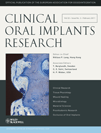The effect of water pyrolysis on the removal torque of titanium implant inserted in rabbit tibias
Abstract
Objective: The aim of this study is to examine the effect of oxidation with water pyrolysis (OWP) method on titanium (Ti) implants by comparing the bonding strength between bone and Ti implants that were inserted in the proximal tibia metaphysic of a rabbit for 12 weeks. The removal torque was measured to evaluate the bonding strength for different Ti implants with and without the OWP method.
Material and methods: Nine sets of threaded Ti implants (ASTM grade 2) of diameter 3.75 mm and length 5 mm were prepared for the experiment. Each set was composed of four specimens; one was machine-prepared (group D) and the other three were threaded followed by the OWP method at 300°C (group A), 600°C (group B), and 800°C (group C) for 10 min, respectively. Each set was used for each adult rabbit. To eliminate the effect of the sites or the legs, each rabbit received all four implants, two in the left and two in the right leg, inserted in the proximal tibia metaphyses of the left leg, using a fixed block randomization. After 12 weeks, removal torque tests were carried out.
Results: The mean removal torque for the control group D was 16.19 N cm, while the mean removal torque values for the OWP groups A, B, and C were 26.75, 31.51, and 41.05 N cm, respectively. The removal torques obtained from the OWP groups B and C (showing the rutile oxide structure) were significantly greater than that for the control group by Bonferroni's-corrected Wilcoxon's signed-rank test (P<0.05).
Conclusion: The strongest bonding between bone and group C (OWP method at 800°C) was confirmed by the comparison of removal torques.
To cite this article: S-H Park, WB Song, KH Kim, DJ Soe, S-A Cho. The effect of water pyrolysis on the removal torque of titanium implant inserted in rabbit tibias.Clin. Oral Impl. Res. 22, 2011; 157–164.doi: 10.1111/j.1600-0501.2010.01971.x




